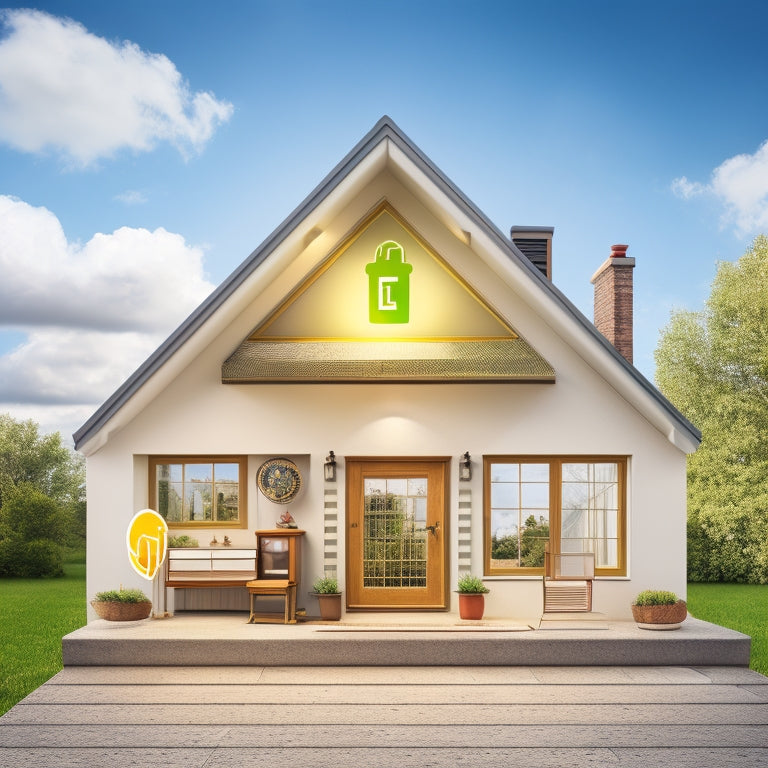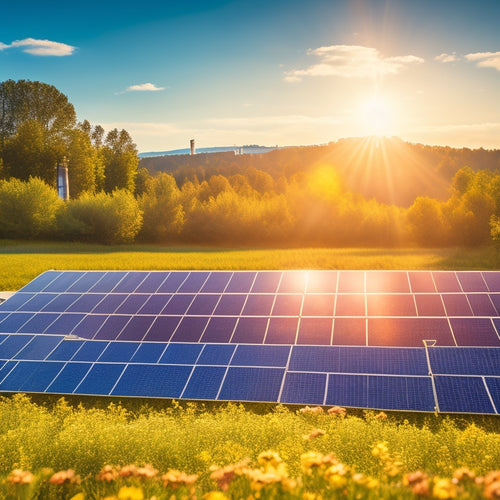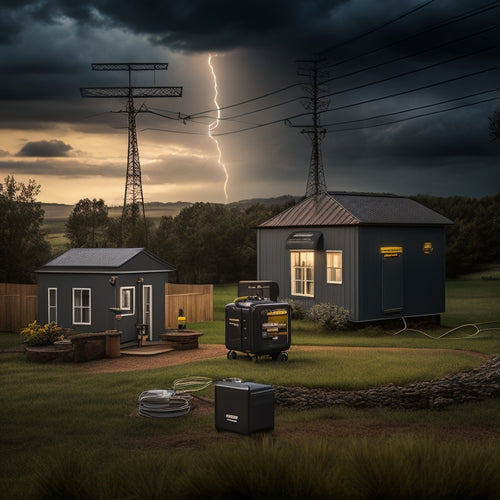
Energy Efficiency Home Audit Essentials Checklist
Share
You're taking the first step towards reducing your energy consumption and saving on utility bills by conducting a thorough energy efficiency home audit. Start by gathering documents and data, defining energy goals, and engaging with your energy provider for usage revelations. Inspect your home's insulation, lighting, and appliances, and check your HVAC system's performance. Don't forget to review water conservation opportunities, electrical outlets, and switches. By following this essential checklist, you'll identify areas for improvement and prioritize upgrades that will make the most impact, and you'll be well on your way to discovering even more ways to optimize your home's energy efficiency.
Overview
- Gather documents and data to define energy goals and prioritize areas for improvement before conducting an energy audit.
- Inspect insulation, HVAC systems, lighting, and appliances to identify inefficiencies and opportunities for improvement.
- Use tools like incense sticks or candles to detect air leaks and document draft locations for sealing to reduce heat loss.
- Implement simple changes like replacing incandescent bulbs with LEDs or CFLs and unplugging unused appliances to lower energy consumption.
- Regularly review energy bills and conduct energy audits to track progress, identify areas for improvement, and optimize energy use.
Pre-Audit Preparation Essentials
Gather necessary documents and information before conducting an energy efficiency home audit to guarantee a thorough and accurate assessment.
You'll need to define your energy goals and identify areas of priority. Consider investing in high-efficiency solar panels and durable mounting systems to maximize energy harvesting Top-Rated DIY Solar Kits.
Engage with your energy provider to access your usage data, and consider seeking professional assistance if you're new to energy audits.
Develop a checklist of areas to inspect, including lighting, HVAC systems, and appliances. Familiarize yourself with audit tools and local incentives that can support your DIY improvements.
Be aware of common efficiency myths and understand the data analysis process to guarantee accurate results.
Insulation and Draft Detection
With your pre-audit preparation complete, you're ready to inspect your home's insulation and detect drafts.
Start by checking your attic, walls, and floors for adequate insulation materials, such as fiberglass, cellulose, or spray foam. Verify they're installed correctly and meet local building code requirements.
Consider conducting an energy audit to identify inefficiencies and optimize energy usage energy independence starter kits.
Next, use a lit incense stick or candle to detect air leaks around windows, doors, electrical outlets, and switches. Hold the flame near potential gaps, and if it flickers or moves, you've found a draft.
Make note of these areas for draft sealing. Proper insulation and draft sealing can greatly reduce heat loss and energy consumption, saving you money and increasing your home's comfort.
Lighting and Appliance Efficiency
About half of the energy consumed in your home is attributed to lighting and appliances. This makes it a vital area to focus on during your energy efficiency home audit.
Start by evaluating your lighting. Are you still using traditional incandescent bulbs? Consider replacing them with energy-saving bulbs, such as LEDs or CFLs, which can last up to 25 times longer and use considerably less energy.
For instance, integrating your lighting with a home battery system like the LG Chem RESU can optimize energy storage and reduce grid reliance. Additionally, exploring modular designs like SimpliPhi Power can provide customized energy solutions.
Next, examine your appliances. Are they old and inefficient? Appliance upgrades, like replacing old refrigerators or washing machines with Energy Star-rated models, can make a substantial impact.
Additionally, unplug appliances when not in use to eliminate standby power consumption. By making these simple changes, you can considerably reduce your energy consumption and lower your utility bills.
HVAC System Performance Check
You'll want to inspect your HVAC system's age and condition to determine if it's operating efficiently.
Additionally, you should check the filter condition and maintenance history, as a dirty or clogged filter can considerably reduce system performance.
System Age and Condition
Inspect your HVAC system's age and condition to determine its impact on energy efficiency.
You'll want to check the system's manufacture date, as units over 10 years old may be inefficient and wasting energy.
Take note of any rust, corrosion, or signs of wear on components like coils, fans, and compressors.
If you find issues, consider system upgrades or replacement options to improve efficiency and reduce energy costs.
Be aware that older systems may not be compatible with newer, more efficient components, making replacement a more viable option.
Take photos and notes to reference later, as this information will help you prioritize improvements and create a plan for a more energy-efficient home.
Filter Condition and Maintenance
Efficiency hinges on proper filter maintenance, as clogged or dirty filters can greatly impede your HVAC system's performance and energy efficiency.
You'll want to check your filters monthly and replace them every 1-3 months, depending on usage and filter types.
Look for signs of wear, such as dirt buildup, rust, or musty odors. Don't forget to check the filter's MERV rating, which indicates its ability to capture particles. A higher rating means better air quality, but may also increase pressure drop and reduce airflow.
Consider upgrading to a high-efficiency filter or a smart filter that alerts you when it needs replacement.
Regular filter maintenance guarantees your HVAC system runs smoothly, efficiently, and effectively, saving you money and energy.
Water Conservation Opportunities
Water conservation opportunities abound in the typical home, with many simple and cost-effective measures waiting to be implemented.
You can start by inspecting your faucets and toilets for leaks, which can waste up to 20 gallons of water per day. Installing low-flow fixtures and greywater recycling systems can greatly reduce your water usage.
Consider rainwater harvesting systems, which collect and store rainwater for non-potable uses like watering plants or washing cars. Additionally, check your water meter to detect hidden leaks and install water-efficient appliances.
Electrical Outlet and Switch Review
You'll want to inspect your electrical outlets and switches to identify potential energy-wasting culprits.
Start by evaluating the condition of your outlets, looking for signs of wear or damage.
Next, inspect the switch plates to verify they're securely fastened and functioning properly, and identify any worn-out outlets that need replacement.
Outlet Condition Assessment
During a home energy audit, outlets and switches are often overlooked, yet they can greatly impact your energy efficiency.
As you inspect your outlets, look for signs of wear, overheating, or corrosion. Check for loose or damaged outlet covers, which can compromise outlet safety and lead to energy loss.
Make certain outlets aren't overloaded with multiple plugs, as this can cause heat buildup and increase the risk of electrical fires.
Also, inspect the outlet's grounding and polarization to verify they're functioning properly.
Switch Plate Inspection
Having evaluated the condition of your outlets, it's time to turn your attention to the switch plates that control the flow of electricity to these outlets.
Now, inspect the switch plates for any signs of wear, damage, or improper installation. Check the switch plate materials, confirming they're durable and suitable for the electrical load they're handling.
Verify that the switch plate placement is correct, with switches installed at a comfortable height and distance from the floor.
Also, make certain that switch plates are securely fastened to the wall, with no signs of looseness or sagging.
Properly installed and maintained switch plates are essential for safe and efficient electrical distribution throughout your home.
Worn-Out Outlet Identification
Many homes have at least a few worn-out outlets that can decrease energy efficiency and even pose a fire hazard. As you inspect your outlets, look for signs of wear and tear that can lead to energy loss and compromised outlet safety.
| Outlet Condition | Action Needed |
|---|---|
| Cracked or broken outlets | Replace immediately to prevent shock or fire |
| Outlets with loose or worn-out prongs | Tighten or replace to guarantee secure connections |
| Outlets with burn marks or signs of overheating | Replace and investigate underlying causes |
| Outlets with missing or broken faceplates | Replace faceplates to prevent electrical shock |
Frequently Asked Questions
Can Energy Audits Be Done During Extreme Weather Conditions?
When you're considering an energy audit, you'll want to avoid scheduling it during extreme weather conditions, as they can impact the accuracy of the results, making it harder to identify areas for improvement and optimize your energy usage.
Are Energy Audits Only for Old or Inefficient Homes?
You think energy audits are only for old, clunky homes? Think again! They're for anyone seeking energy savings and home improvements, regardless of age or efficiency, to help you break free from energy waste and skyrocketing bills.
Do Energy Auditors Need Access to Every Room in the House?
When you hire an energy auditor, they'll need access to every room in the house to identify areas of energy loss, as each room's significance in the energy audit process cannot be overstated, ensuring a thorough assessment of your home's energy efficiency.
Can I Perform an Energy Audit Myself Without a Professional?
As you hold the flashlight of curiosity, shining it on your home's hidden corners, you wonder: can you uncover its energy secrets solo? Yes, you can perform a DIY energy audit, conducting a home energy assessment to identify areas of improvement, but be prepared to get hands-on and detail-oriented.
Are Energy Audits Covered by Homeowners' Insurance Policies?
You'll typically find that home insurance policies don't cover energy audits as a standalone service, but some may reimburse you for audit costs if you're making energy-efficient upgrades that reduce insurance risks, like installing new roofing or insulation.
Ready to Buy
You've finally made it to the end of this exhaustive energy efficiency home audit essentials checklist. Ironically, the most energy-draining part of this process might be flipping the switch on your newfound awareness of just how much energy your home is wasting. But don't let that thought leave you in the dark - use this newfound knowledge to power your way towards a more sustainable future, and reap the benefits of a lower energy bill to boot.
Related Posts
-

Advantages of Solar Generating Systems Over Traditional Energy
Solar generating systems provide several key advantages over traditional energy sources. You'll experience lower long...
-

Key Components of a Reliable Emergency Power Supply System
A reliable emergency power supply system requires several key components. You need proven performance metrics to guar...
-

High-Efficiency Solar Battery Chargers for Remote Areas
High-efficiency solar battery chargers are essential for your off-grid energy needs in remote areas. They maximize en...


